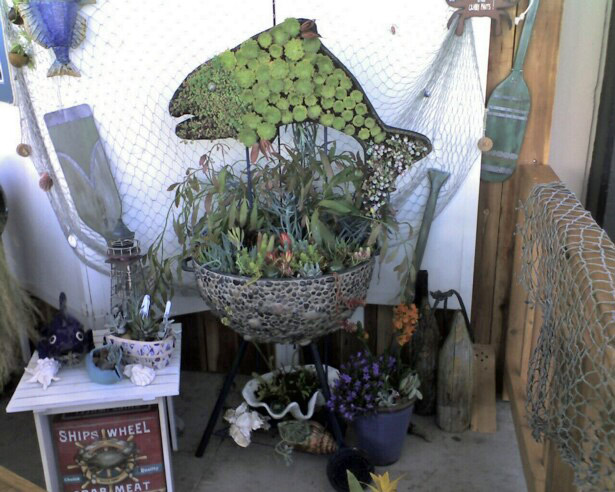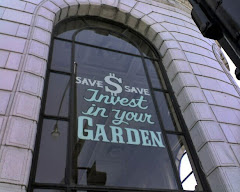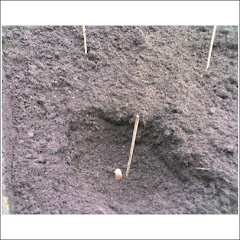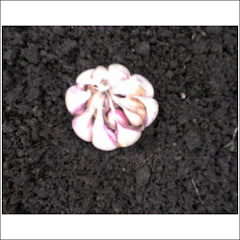This week I drove up to Petaluma to visit the Baker Creek Seed store which just celebrated it's first year annivesary. What a cool place. If you love heirloom varieties of vegetables and herbs or flowers, then this is the place for you. They carry 1,400 types of rare non-genetically modified seeds.
The place is full of seeds and garden gifts as well as books and videos. This is a "MUST STOP IN" place if you are on the way up to Santa Rosa or beyond. (Corner of Petaluma Blvd. and Washington.)
FYI - they are closed on Saturdays!
In the meantime, they are on the web and Facebook as well.
http:www.rareseeds.com
Wednesday, June 30, 2010
Aristocratic Thistle - The Artichoke - Half Moon Bay Crops
Making a Killing in the Artichoke Market
New York City, December 21, 1935.
Accompanied by a score of burly policemen, Mayor Fiorello La Guardia made a dramatic pre-dawn appearance at the Bronx Terminal Market, where he was boosted onto the back of a flatbed truck to read a proclamation.
As of December 26, "sale, display and possession" of artichokes would be outlawed in the city of New York. The vegetable, La Guardia declared, was at the root of a million-dollar-a-year criminal operation involving extortion, violence, kidnapping and murder. "A racketeer in artichokes is no different than a racketeer in slot machines," said the mayor.
Americans who thought they'd seen it all were taken aback. Prostitution, bootlegging and numbers running OK, but a vegtable racket?
La Guardia's pronouncement made headlines - both in the East, where the vast majority of American artichokes were consumed, and in the West, in bucolic Half Moon Bay, where 95 percent of the vegetables were grown.
Commercial planting of the thistle, long a delicacy in southern Europe, was pioneered in the United States by Half Moon Bay's Italian farmers during the 1890s. (No artichokes were commercially grown in Castroville until 1924.)
The first artichokes were shipped east in 1904, to be sold in the stalls of public markets and from pushcarts in the predominantly Italian sections of New York, Connecticut and New Jersey. Not long thereafter, refrigerated railroad cars left the Peninsula daily, distributing loads of the thistle throughout the East.
The racketeering began in 1930, when notorious New York gangster Ciro Terranova set out to corner the artichoke market. Eastern importers were forced to sell only to him. He in turn doubled the prices to customers. Mayor La Guardia conservatively estimated that Terranova, crowned "artichoke king and food
racket emperor" by a local newspaper, was pocketing $500,000 a year.
Thugs stopped rail shipments, forced open doors and informed consignees what the syndicate would pay for the cargo. One Half Moon Bay grower testified, "We either accepted their price or got our skulls cracked."
Local growers were coerced into selling to a single source. When there was a glut, production was curtailed by threats and acts of violence. The "artichoke wars" erupted along the usually tranquil San Mateo coast in the fall of 1930, when machete-wielding gangs invaded the lush fields to force compliance by growers who refused to cooperate. Vegetable trucks were hijacked, equipment destroyed and packed crates stolen from warehouses. Acres of valuable plants were methodically slashed. Losses to farmers in 1930-31 for crated
artichokes alone were estimated at $100,000.
Pugnacious growers fought back, forming gangs of "artichoke vigilantes" to safeguard fields. San Mateo County Sheriff James McGrath dispatched squads of deputies armed with sawed-off shotguns to patrol roads from Moss Beach to Pescadero, but the vast, isolated reaches of the Coastside were almost impossible to police effectively and raids continued nightly.
In November 1931, vigilantes and mobsters fought a predawn battle on Ernest Consani's farm near Princeton. Raiders, caught heisting crates of artichokes, were fired upon by vigilantes. The windshield of the getaway car was shattered and at least one thug was wounded.
New York's ban on artichokes was only temporary: questions regarding its legality had been raised immediately, but La Guardia struggled to liberate his city from the vegtable mobsters for two years. Ciro Terranova and his henchmen were eventually prosecuted for racketeering, restraint of trade and
conspiracy to violate interstate commerce regulations. Scores of government witnesses testified to the gang's methodic use of violence, terrorism, kidnapping and other outrages to wring compliance from growers, shippers and wholesalers.
Five mob leaders were tried, but New York juries deadlocked on two occasions. When it became apparent that authorities would push for a third trial, all defendants pleaded guilty to lesser charges and were sent to prison.
Some Half Moon Bay growers applauded the New York mayor's crackdown. Others weren't so sure. John Debenedetti, son of the founder of the Half Moon Bay Artichoke Association, once noted that the Eastern mob indirectly helped local farmers. After all, Terranova and his punks had bought 100 percent of the San Mateo crop, but when mob activity came to an end, growers once again had to deal with the free market.
In the long run, though, La Guardia's action drew attention to what the growers' association affectionately called the "aristocratic thistle", succeeding where growers had failed. The artichoke industry had spent more than $100,000 on a national advertising campaign, with disappointing results.
But when artichokes became front-page news, growers were swamped with orders. Thousands of citizens across the nation longed to give one a try. Newspapers and magazines were suddenly crammed with recipes on how to prepare this "delight of the epicure" and readers were coached on how to eat them.
Prodded, Mayor La Guardia admitted to being a connoisseur of the "educated thistle" himself, revealing that he preferred the vegetable with mayonnaise sauce.
[Reposted without permission from article by Michael Svanevik, a professor of history at College of San Mateo, and Shirley Burgett, a specialist in historical research.]
New York City, December 21, 1935.
Accompanied by a score of burly policemen, Mayor Fiorello La Guardia made a dramatic pre-dawn appearance at the Bronx Terminal Market, where he was boosted onto the back of a flatbed truck to read a proclamation.
As of December 26, "sale, display and possession" of artichokes would be outlawed in the city of New York. The vegetable, La Guardia declared, was at the root of a million-dollar-a-year criminal operation involving extortion, violence, kidnapping and murder. "A racketeer in artichokes is no different than a racketeer in slot machines," said the mayor.
Americans who thought they'd seen it all were taken aback. Prostitution, bootlegging and numbers running OK, but a vegtable racket?
La Guardia's pronouncement made headlines - both in the East, where the vast majority of American artichokes were consumed, and in the West, in bucolic Half Moon Bay, where 95 percent of the vegetables were grown.
Commercial planting of the thistle, long a delicacy in southern Europe, was pioneered in the United States by Half Moon Bay's Italian farmers during the 1890s. (No artichokes were commercially grown in Castroville until 1924.)
The first artichokes were shipped east in 1904, to be sold in the stalls of public markets and from pushcarts in the predominantly Italian sections of New York, Connecticut and New Jersey. Not long thereafter, refrigerated railroad cars left the Peninsula daily, distributing loads of the thistle throughout the East.
The racketeering began in 1930, when notorious New York gangster Ciro Terranova set out to corner the artichoke market. Eastern importers were forced to sell only to him. He in turn doubled the prices to customers. Mayor La Guardia conservatively estimated that Terranova, crowned "artichoke king and food
racket emperor" by a local newspaper, was pocketing $500,000 a year.
Thugs stopped rail shipments, forced open doors and informed consignees what the syndicate would pay for the cargo. One Half Moon Bay grower testified, "We either accepted their price or got our skulls cracked."
Local growers were coerced into selling to a single source. When there was a glut, production was curtailed by threats and acts of violence. The "artichoke wars" erupted along the usually tranquil San Mateo coast in the fall of 1930, when machete-wielding gangs invaded the lush fields to force compliance by growers who refused to cooperate. Vegetable trucks were hijacked, equipment destroyed and packed crates stolen from warehouses. Acres of valuable plants were methodically slashed. Losses to farmers in 1930-31 for crated
artichokes alone were estimated at $100,000.
Pugnacious growers fought back, forming gangs of "artichoke vigilantes" to safeguard fields. San Mateo County Sheriff James McGrath dispatched squads of deputies armed with sawed-off shotguns to patrol roads from Moss Beach to Pescadero, but the vast, isolated reaches of the Coastside were almost impossible to police effectively and raids continued nightly.
In November 1931, vigilantes and mobsters fought a predawn battle on Ernest Consani's farm near Princeton. Raiders, caught heisting crates of artichokes, were fired upon by vigilantes. The windshield of the getaway car was shattered and at least one thug was wounded.
New York's ban on artichokes was only temporary: questions regarding its legality had been raised immediately, but La Guardia struggled to liberate his city from the vegtable mobsters for two years. Ciro Terranova and his henchmen were eventually prosecuted for racketeering, restraint of trade and
conspiracy to violate interstate commerce regulations. Scores of government witnesses testified to the gang's methodic use of violence, terrorism, kidnapping and other outrages to wring compliance from growers, shippers and wholesalers.
Five mob leaders were tried, but New York juries deadlocked on two occasions. When it became apparent that authorities would push for a third trial, all defendants pleaded guilty to lesser charges and were sent to prison.
Some Half Moon Bay growers applauded the New York mayor's crackdown. Others weren't so sure. John Debenedetti, son of the founder of the Half Moon Bay Artichoke Association, once noted that the Eastern mob indirectly helped local farmers. After all, Terranova and his punks had bought 100 percent of the San Mateo crop, but when mob activity came to an end, growers once again had to deal with the free market.
In the long run, though, La Guardia's action drew attention to what the growers' association affectionately called the "aristocratic thistle", succeeding where growers had failed. The artichoke industry had spent more than $100,000 on a national advertising campaign, with disappointing results.
But when artichokes became front-page news, growers were swamped with orders. Thousands of citizens across the nation longed to give one a try. Newspapers and magazines were suddenly crammed with recipes on how to prepare this "delight of the epicure" and readers were coached on how to eat them.
Prodded, Mayor La Guardia admitted to being a connoisseur of the "educated thistle" himself, revealing that he preferred the vegetable with mayonnaise sauce.
[Reposted without permission from article by Michael Svanevik, a professor of history at College of San Mateo, and Shirley Burgett, a specialist in historical research.]
Subscribe to:
Comments (Atom)










